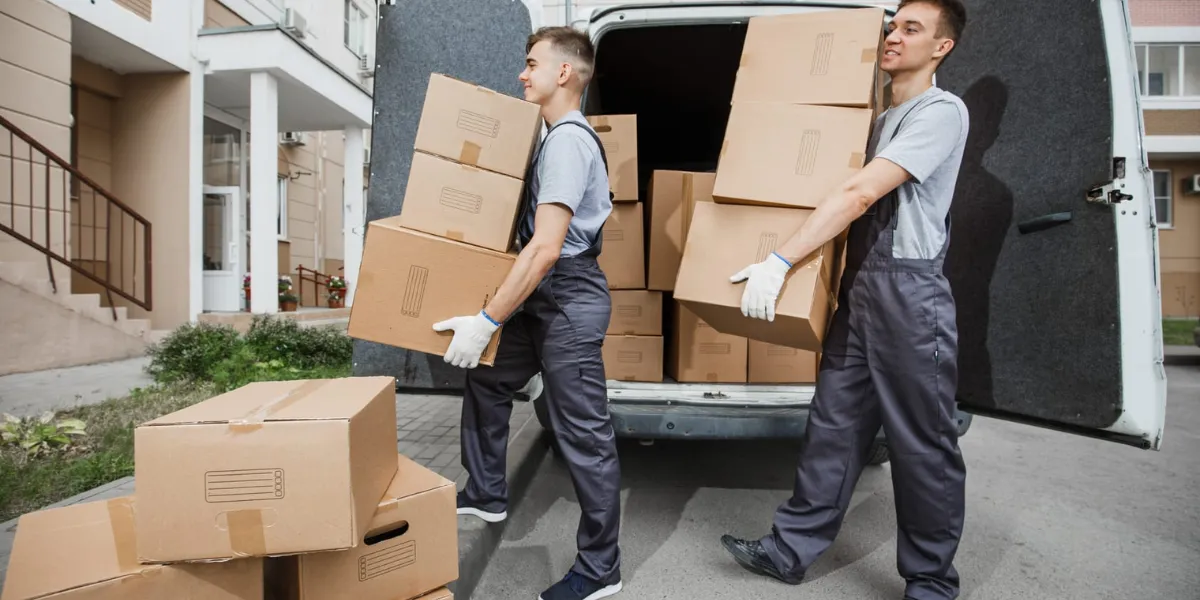Smart Planning: The Blueprint for a Stress-Free Move

How Can Shifting Homes Become Super Easy events, but with smart planning, it can be transformed into a smooth and manageable process. The key to a stress-free move lies in creating a detailed and thoughtful plan that addresses every aspect of the transition.
Step-by-Step Guide:
Start Early:
Begin planning your move at least two months in advance. This gives you ample time to sort, pack, and handle any unexpected issues that might arise.
Create a Moving Timeline:
Develop a timeline that outlines all the tasks you need to complete before moving day. This should include booking movers, gathering packing supplies, notifying utilities and services, and any other relevant tasks.
Inventory and Declutter:
Make an inventory of all your belongings. Decide what to keep, what to donate, sell, or discard. Decluttering reduces the amount of stuff you need to move and can make unpacking easier.
Research Moving Companies:
Investigate and compare moving companies well in advance. Look for reviews, ask for quotes, and check for any additional services they offer that could make your move easier, such as packing and unpacking.
Budgeting:
Establish a moving budget that covers all potential expenses, including moving company fees, packing supplies, transportation, and any contingencies. Sticking to a budget helps prevent financial stress.
Gather Supplies:
Collect all necessary packing materials, such as boxes, tape, bubble wrap, and markers. Having the right supplies on hand ensures your belongings are protected during the move.
Pack Strategically:
Pack non-essential items first and save daily essentials for last. Label boxes clearly with their contents and the room they belong to in the new home. Consider creating an “essentials” box with items you’ll need immediately after moving.
Notify Necessary Parties:
Inform relevant parties about your move, including utility companies, banks, postal services, and any subscriptions or memberships. Arrange for the transfer or setup of new services at your new home.
Plan Moving Day Logistics:
Organize the logistics of moving day, including transportation, parking, and access to your new home. Make sure you have a clear plan for handling pets and children during the move.
Prepare for the Unexpected:
Have a backup plan in case of delays or issues. This could include having extra packing supplies, keeping important documents and valuables with you, and knowing the contact details of your moving company and emergency services.
By following these steps and maintaining a clear, organized approach, you can significantly reduce the stress and chaos often associated with moving. Smart planning is your blueprint for a successful, stress-free move, ensuring that you transition smoothly into your new home.
The Ultimate Moving Checklist: Stay Organized from Start to Finish

Moving homes is a complex process that requires careful coordination and organization. An ultimate moving checklist ensures that you stay on track and manage every aspect of your move efficiently, minimizing stress and avoiding last-minute surprises.
Comprehensive Checklist:
Two Months Before Moving:
Create a Moving Binder: Keep all your moving documents, receipts, and checklists in one place.
Research Moving Companies: Get quotes, read reviews, and book your moving company.
Budgeting: Outline all potential moving costs, including movers, supplies, and travel expenses.
Declutter: Sort through your belongings and decide what to keep, donate, sell, or discard.
Notify Schools: If you have children, inform their current schools and arrange for the transfer of records to new schools.
Six Weeks Before Moving:
Order Packing Supplies: Purchase boxes, tape, bubble wrap, and other packing materials.
Begin Packing: Start with non-essential items, labeling boxes with their contents and intended rooms.
Notify Service Providers: Inform utilities, internet, and other service providers about your move and arrange for disconnections or transfers.
Medical Records: Collect medical, dental, and veterinary records and notify your healthcare providers about the move.
One Month Before Moving:
Confirm Moving Arrangements: Reconfirm your moving date and details with the moving company.
Change Address: Update your address with the postal service, banks, insurance companies, and other important contacts.
Arrange for Child and Pet Care: Plan for someone to look after your children and pets on moving day.
Transfer or Cancel Memberships: Handle gym memberships, clubs, and subscriptions.
Two Weeks Before Moving:
Finalize Packing: Continue packing, leaving only essentials for the last week.
Label Boxes: Clearly mark boxes with contents and destination rooms to streamline unpacking.
Service Vehicles: Ensure your car is in good condition if you’re driving to your new home.
Plan Meals: Create a meal plan to use up perishable food items and avoid food waste.
One Week Before Moving:
Pack a Moving Day Kit: Include essentials like toiletries, a change of clothes, important documents, and any medications.
Defrost the Fridge: Clean and defrost your refrigerator and freezer.
Confirm Details: Double-check the schedule with your movers and provide them with directions and your contact information.
Backup Electronics: Save important files and data from your computers and other devices.
Moving Day:
Supervise the Move: Be present to oversee the movers, ensuring everything is handled with care.
Final Walkthrough: Conduct a final check of your old home to ensure nothing is left behind.
Manage Utilities: Confirm that all utilities are turned off or transferred.
Secure New Home: Make sure utilities are turned on at your new home and check for any immediate issues.
After the Move:
Unpack Essentials: Start with your moving day kit and essentials boxes.
Settle In: Begin unpacking room by room, focusing on the kitchen, bedrooms, and bathrooms first.
Update Records: Ensure all relevant parties are aware of your new address, including the DMV and voter registration.
Explore the Neighborhood: Familiarize yourself with local amenities, services, and community resources.
By following this ultimate moving checklist, you can stay organized throughout the entire process, from the early planning stages to settling into your new home. This thorough and methodical approach helps ensure that nothing is overlooked, making your move as smooth and stress-free as possible.
Hiring Professional Movers: Tips for Choosing the Right Service

Selecting the right professional moving company is crucial for ensuring a smooth and hassle-free move. Here are key tips to guide you through the process of hiring movers who are reliable, efficient, and a good fit for your specific needs.
Steps to Choose the Right Moving Service:
Start with Research:
Gather Recommendations: Ask friends, family, and colleagues for recommendations based on their experiences.
Online Reviews: Check online review platforms like Google, Yelp, and the Better Business Bureau to gauge the reputation of potential moving companies.
Verify Credentials: Ensure the moving company is licensed and insured. In the U.S., check their registration with the Federal Motor Carrier Safety Administration (FMCSA) for interstate moves.
Get Multiple Quotes:
Obtain Estimates: Contact at least three different moving companies to get detailed quotes. Ensure that each quote is based on an in-person or virtual survey of your belongings to avoid any surprises.
Compare Costs and Services: Look beyond the price. Compare the services included in the estimates, such as packing, loading, unloading, and unpacking, as well as any additional fees.
Ask the Right Questions:
Experience and Expertise: Inquire about the company’s experience in the moving industry, particularly with moves similar to yours (e.g., long-distance, international, high-value items).
References: Request references from past clients and follow up to hear about their experiences.
Contract and Policies: Understand the terms of the contract, cancellation policies, and what is covered under their insurance. Ensure clarity on liability for damaged or lost items.
Evaluate Their Professionalism:
Transparency: A reputable moving company will provide clear and detailed information without hidden fees or vague terms.
Customer Service: Gauge their responsiveness and willingness to answer questions. Good communication is a sign of a reliable service.
Physical Address: Verify that the company has a physical office location. Be wary of companies that only provide a phone number and a website.
Check for Red Flags:
Large Upfront Deposits: Be cautious of companies that demand large deposits before the move. Most reputable movers only require a small deposit or payment upon delivery.
Name Switches: Some companies frequently change their names to avoid negative reviews or legal issues. Ensure consistency in the company’s name on estimates, contracts, and their website.
Incomplete Paperwork: Avoid companies that do not provide a complete written estimate or contract. Always get everything in writing.
Understand Your Rights and Responsibilities:

Rights and Responsibilities: Familiarize yourself with the “Your Rights and Responsibilities When You Move” booklet provided by the FMCSA if you are moving interstate. This document outlines what you need to know about working with professional movers.
Insurance Options: Know the different levels of liability the moving company offers. Basic coverage is usually included, but you may want to purchase additional insurance for full value protection.
Plan Ahead:
Book Early: Moving companies can be booked months in advance, especially during peak moving seasons (summer and end of the month). Plan and book your movers as early as possible.
Confirm Details: Reconfirm all details with your moving company a week before your move. Verify the date, time, and services to avoid any misunderstandings.
By following these tips, you can select a professional moving service that meets your needs, budget, and expectations. The right movers can make a significant difference in the ease and success of your relocation, allowing you to focus on settling into your new home.
Efficient Packing Hacks: Save Time and Space
Packing for a move can be a daunting task, but with efficient strategies, you can save both time and space. Here are some practical packing hacks to streamline the process and make your move more manageable.
Start Early and Declutter:
Begin Early: Start packing well in advance to avoid last-minute stress. Aim to pack non-essential items first.
Declutter: Go through your belongings and decide what to keep, donate, sell, or discard. Reducing the amount of stuff you have to move saves time and space.
Use the Right Supplies:
Sturdy Boxes: Invest in good-quality boxes in various sizes. Use small boxes for heavy items and large boxes for lighter items.
Packing Materials: Stock up on bubble wrap, packing paper, and tape. Use soft items like towels and clothing to wrap fragile items.
Labels and Markers: Label boxes clearly with their contents and the room they belong to inyour new home.
Pack Smartly:
Room-by-Room: Pack one room at a time to stay organized and make unpacking easier.
Heaviest Items First: Place the heaviest items at the bottom of the box and lighter items on top.
Color-Code Boxes: Use colored labels or markers to designate boxes for different rooms.
Maximize Space:
Roll Clothing: Rolling clothes instead of folding them saves space and reduces wrinkles.
Vacuum-Seal Bags: Use vacuum-seal bags for bulky items like bedding and winter clothes to compress them and save space.
Utilize All Space: Fill every gap in your boxes with smaller items to maximize space and prevent shifting during transit.
Keep Essentials Accessible:
Essentials Box: Pack a box with essentials you’ll need immediately after the move, such as toiletries, a change of clothes, important documents, and basic kitchen items.
First Night Bag: Prepare a bag with items for your first night in your new home, including pajamas, bedding, and basic toiletries.
Protect Fragile Items:
Layering: Use multiple layers of protection for fragile items. Start with packing paper, followed by bubble wrap, and secure with tape.
Dividers: Use cardboard dividers for items like glassware and plates to prevent them from touching each other.
Label Fragiles: Clearly label boxes containing fragile items to ensure they are handled with care.
Utilize Household Items:
Suitcases and Duffel Bags: Pack clothes, books, and other heavy items in suitcases and duffel bags for easy transport.
Drawers and Baskets: Use drawers from dressers and baskets to pack items, wrapping them with plastic wrap to keep contents in place.
Efficient Packing Techniques:
Bundle Cables and Cords: Use twist ties or zip ties to bundle cables and cords, labeling them for easy setup later.
Photo Documentation: Take photos of complex setups, like electronics, to make reassembly easier in your new home.
Ziplock Bags: Use ziplock bags for small items like screws, bolts, and remote controls. Label the bags and tape them to the corresponding items.
Utilize Space Creatively:
Nesting: Place smaller items inside larger ones to save space. For example, put spices inside pots.
Stacking: Stack boxes and items efficiently in the moving truck, keeping heavier items at the bottom and lighter ones on top.
Stay Organized:
Packing Inventory: Keep a detailed inventory of what is in each box. Number the boxes and list their contents in a notebook or on your phone.
Clear Labeling: Label boxes with their destination room and a brief description of contents. Consider using color-coded labels for each room.
By implementing these efficient packing hacks, you can streamline your moving process, save valuable time, and optimize space. These strategies not only make packing easier but also ensure that unpacking in your new home is quick and straightforward.
Utilizing Technology: Apps and Tools to Simplify Your Move

In today’s digital age, technology can significantly streamline the moving process. From planning and organizing to executing the move and settling into your new home, various apps and tools can make every step easier and more efficient.
Essential Apps and Tools for a Smooth Move:
Moving Checklists and Planner Apps:
Move Advisor: This app offers a comprehensive moving timeline and checklist, helping you stay organized by breaking down tasks week by week.
Sortly: A visual inventory management app that allows you to categorize and keep track of your belongings with photos, making packing and unpacking more efficient.
acking and Inventory Management:
BoxHero: Helps you manage and track your packed boxes. You can label each box and list its contents, making it easy to find items after the move.
MagicPlan: This app allows you to create floor plans and layouts for your new home, aiding in planning where your furniture and belongings will go.
Finding and Hiring Movers:
HireAHelper: Connects you with local moving labor, providing reviews and cost estimates to help you choose the best service.
Unpakt: Allows you to compare prices, read reviews, and book reputable moving companies all in one place.
Budgeting and Cost Management:
Moving Calculator by Moving.com: Provides cost estimates based on the size of your move, the distance, and additional services you might need, helping you budget effectively.
Mint: A personal finance app that helps you track your moving expenses and stay within your budget.
Address Change and Utility Management:
Updater: Simplifies the process of changing your address, transferring utilities, and forwarding mail, saving you time and hassle.
MyMove: Assists with updating your address with the postal service and provides checklists and tips for managing utility transfers.
Digital Organization and Document Management:
Evernote: A note-taking app that allows you to keep all your moving plans, lists, and documents in one place, accessible from any device.
Dropbox: Use it to store important documents, receipts, and contracts related to your move in a secure, easily accessible location.
Navigation and Local Services:
Google Maps: Essential for planning your moving route and exploring your new neighborhood. You can find local services, schools, grocery stores, and more.
Nextdoor: A social networking app for neighborhoods, helping you connect with your new community and get recommendations for local services and activities.
Stress Management and Wellness:
Headspace: A meditation and mindfulness app that can help reduce moving-related stress and keep you mentally balanced during the hectic process.
Calm: Offers relaxation techniques and sleep aids to help you unwind and get a good night’s rest amid the chaos of moving.
Pet and Child Care:
Rover: Connects you with local pet sitters and dog walkers to help manage your pets during the moving process.
UrbanSitter: Helps you find trusted babysitters and nannies in your area, ensuring your children are well cared for on moving day.
Moving Day Coordination:
TaskRabbit: Allows you to hire local helpers for various tasks, such as packing, furniture assembly, and heavy lifting, making moving day smoother.
Lugg: An on-demand moving service that provides quick and easy transportation for small moves or individual items.
By utilizing these apps and tools, you can simplify every aspect of your move. Technology helps you stay organized, manage your time and resources efficiently, and reduce stress, ensuring a smoother transition to your new home.
Decluttering Before the Move: How to Lighten Your Load

Decluttering before a move is a crucial step that can make the entire moving process more efficient, cost-effective, and stress-free. By reducing the number of items you need to pack and transport, you can save time, money, and energy. Here are some strategies to help you declutter effectively before your move.
Steps to Declutter Effectively:
Start Early:
Begin Well in Advance: Start the decluttering process as soon as you know you’ll be moving. This gives you ample time to sort through your belongings without feeling rushed.
Create a Plan:
Room-by-Room Approach: Tackle one room at a time to stay organized and focused. Create a checklist for each room to ensure you cover all areas.
Set Goals and Deadlines: Establish specific goals and deadlines for each room to keep yourself on track and motivated.
Sort and Categorize:
Use Four Boxes: Label four boxes as Keep, Donate, Sell, and Trash. As you go through each item, place it in the appropriate box.
Be Honest with Yourself: Assess each item critically. If you haven’t used it in the past year, it’s likely you don’t need it.
Declutter Strategically:
Clothing: Evaluate your wardrobe. Donate or sell clothes that no longer fit or that you haven’t worn in a while.
Books and Media: Keep only those books, DVDs, and CDs that you truly love or will use again. Donate or sell the rest.
Kitchen Items: Get rid of duplicate utensils, outdated gadgets, and appliances you rarely use.
Furniture: Consider the size and style of your new home. Sell or donate furniture that won’t fit or match your new space.
Handle Sentimental Items Carefully:
Limit Keepsakes: Keep a select few items that hold the most sentimental value. Take photos of items you want to remember but don’t need to keep.
Digital Memories: Scan and digitize photos and documents to reduce physical clutter while preserving memories.
Dispose of Items Responsibly:
Donation: Donate gently used items to local charities, shelters, or thrift stores. Ensure the items are in good condition.
Selling: Sell valuable items online through platforms like eBay, Craigslist, or Facebook Marketplace. You can also host a garage sale.
Recycling: Recycle items that cannot be donated or sold but are recyclable. Check local recycling guidelines.
Trash: Dispose of broken, unusable items responsibly. Rent a dumpster if you have a large amount of trash.
Organize the Items You’re Keeping:
Storage Solutions: Invest in storage solutions like bins, shelves, and organizers to keep your remaining items tidy.
Labeling: Label boxes and containers clearly to make packing and unpacking easier.
Minimize Paperwork:
Digital Copies: Scan important documents and store them digitally. Shred and recycle unnecessary papers.
Filing System: Organize essential documents in a portable filing system for easy access during the move.
Involve the Whole Family:
Engage Everyone: Get all family members involved in the decluttering process. Assign tasks to each person to speed up the process.
Teach Kids: Use this opportunity to teach children about the benefits of decluttering and donating.
Reward Yourself:
Celebrate Milestones: Celebrate small victories and milestones in the decluttering process to stay motivated.
Enjoy the Results: Appreciate the lighter load and the organized, clutter-free environment you’ve created.
By following these steps, you can effectively declutter your home before moving, making the entire process smoother and more manageable. Lightening your load not only reduces moving stress but also helps you start fresh in your new home.
Budget-Friendly Moving: Cost-Effective Strategies
Moving can be expensive, but with careful planning and smart strategies, you can significantly reduce costs. Here are some budget-friendly tips to help you manage your move without breaking the bank.
Cost-Effective Strategies for Moving:
Plan Ahead:
Early Preparation: Start planning your move as early as possible. This allows you to take advantage of off-peak moving dates and book services in advance, often at lower rates.
Create a Budget: Outline all potential moving expenses, including supplies, transportation, and professional services. Stick to your budget to avoid unexpected costs.
Declutter and Downsize:
Minimize Belongings: Reduce the number of items you need to move by decluttering. Sell, donate, or discard items you no longer need. This can lower moving costs and generate some extra cash.
Yard Sale: Host a yard sale to get rid of unwanted items and make some money to offset moving expenses.
DIY Packing:
Self-Pack: Pack your belongings yourself instead of hiring professional packers. This can save you a significant amount of money.
Free Supplies: Collect free moving boxes from local businesses, friends, or online marketplaces like Craigslist or Freecycle. Use household items like towels and blankets as packing materials.
Compare Moving Quotes:
Get Multiple Estimates: Obtain quotes from several moving companies. Compare their services and prices to find the best deal.
Negotiate: Don’t hesitate to negotiate with moving companies. They may offer discounts or match a competitor’s price to secure your business.
Choose the Right Time to Move:
Off-Peak Season: Move during the off-peak season (fall and winter) when moving companies typically offer lower rates.
Mid-Month, Mid-Week: Avoid moving at the beginning or end of the month and on weekends when demand and prices are higher.
Utilize Moving Discounts:
AAA and Other Memberships: Check if your memberships (e.g., AAA, AARP) offer discounts on moving services.
Employer Reimbursement: If you’re relocating for work, ask your employer if they offer any relocation assistance or reimbursements.
Opt for Portable Storage Containers:
Self-Service Moving: Consider using portable storage containers (like PODS). They are delivered to your home, you load them at your own pace, and they are then transported to your new location.
Hybrid Move: Combine DIY packing with professional transportation to save money while ensuring safe transit.
Rent a Truck:
Self-Drive: Rent a moving truck and drive it yourself. This is often cheaper than hiring full-service movers, especially for short distances.
Mileage and Fuel: Be mindful of the rental company’s mileage and fuel policies to avoid additional charges.
Use Technology:
Moving Apps: Utilize apps like Moving Planner, Sortly, or TaskRabbit to organize your move, find help, and manage tasks efficiently.
Online Marketplaces: Sell unwanted items on platforms like eBay, Facebook Marketplace, or OfferUp to make extra money for your move.
Save on Packing Supplies:
Reusable Containers: Use suitcases, laundry baskets, and storage bins to pack items, reducing the need for boxes.
- Recycled Materials: Use old newspapers, magazines, and shredded paper as packing material instead of buying bubble wrap.
Seek Help from Friends and Family:
Volunteer Help: Ask friends and family to help with packing, loading, and unloading. Offer to return the favor in the future or provide food and drinks as a thank-you.
Borrow Equipment: Borrow moving equipment like dollies, furniture sliders, and tools instead of renting or buying them.
Avoid Hidden Fees:
Read the Fine Print: Carefully review contracts from moving companies to understand all potential fees and avoid surprises.
Insurance: Check if your homeowners or renters insurance covers your move. If not, compare the cost of moving insurance options.
By implementing these budget-friendly strategies, you can manage your move effectively without overspending. Careful planning, utilizing available resources, and being strategic about timing and services will help you keep moving costs down while ensuring a smooth transition to your new home.
Managing Stress: Mental Health Tips for a Smooth Transition
Moving is often cited as one of the most stressful life events. However, with the right strategies, you can manage stress effectively and ensure a smoother transition. Here are some mental health tips to help you stay calm and balanced during your move.
Mental Health Tips for a Smooth Transition:
Plan and Organize:
- Create a Timeline: Develop a moving timeline with specific tasks and deadlines. Breaking the process into manageable steps can reduce feelings of being overwhelmed.
- Use Checklists: Keep checklists for packing, moving tasks, and post-move activities. This helps you stay organized and ensures nothing is forgotten.
Practice Self-Care:
Prioritize Sleep: Ensure you get enough sleep each night. Being well-rested helps you handle stress better and stay focused.
Healthy Eating: Maintain a balanced diet and stay hydrated. Avoid excessive caffeine and sugar, which can increase anxiety.
Exercise: Regular physical activity, even a short walk, can reduce stress and improve your mood.
Take Breaks:
Scheduled Breaks: Set aside time for breaks during your moving tasks. Short, regular breaks can prevent burnout and keep you energized.
Relaxation Techniques: Practice relaxation techniques such as deep breathing, meditation, or yoga to calm your mind and reduce stress.
Stay Connected:
Talk to Friends and Family: Share your feelings and concerns with loved ones. Their support can provide comfort and perspective.
Join Online Forums: Participate in online forums or social media groups related to moving. Connecting with others who are going through similar experiences can be reassuring.
Keep a Positive Mindset:
Focus on the Positive: Remind yourself of the benefits of the move, such as new opportunities and experiences. Keeping a positive outlook can make the transition easier.
Celebrate Small Wins: Acknowledge and celebrate the completion of tasks, no matter how small. This can boost your motivation and morale.
Delegate and Ask for Help:
Hire Professionals: Consider hiring professional movers or cleaners to reduce the workload. This can help alleviate some of the physical and mental stress of moving.
Enlist Friends and Family: Don’t hesitate to ask friends or family for help with packing, organizing, or even moral support.
Stay Flexible:
Expect the Unexpected: Understand that not everything will go as planned. Flexibility and adaptability can help you handle unforeseen challenges without undue stress.
Backup Plans: Have contingency plans for potential issues, such as delays or lost items, to mitigate stress when things don’t go perfectly.
Manage Your Time:
Avoid Procrastination: Start tasks early to avoid last-minute rushes. Spreading out tasks over time makes the process more manageable.
Prioritize Tasks: Focus on high-priority tasks first. Use a priority matrix to determine what needs immediate attention and what can wait.
Practice Mindfulness:
Mindful Moments: Incorporate mindfulness practices into your daily routine. This can help you stay present and reduce anxiety about the future.
Gratitude Journal: Keep a journal to note things you are grateful for each day. This practice can shift your focus from stressors to positive aspects of your life.
Seek Professional Help if Needed:
Therapist or Counselor: If moving stress becomes overwhelming, consider talking to a mental health professional. They can provide strategies and support to manage anxiety and stress.
Support Groups: Join support groups where you can share experiences and coping strategies with others in similar situations.
By implementing these mental health tips, you can manage the stress associated with moving and make the transition smoother and more positive. Taking care of your mental well-being is crucial during such a significant life change, helping you stay calm, focused, and ready to embrace your new beginning.
Unpacking Like a Pro: Settling into Your New Home Quickly
Unpacking efficiently is essential for making your new house feel like home as soon as possible. Here’s how to approach the unpacking process like a pro, ensuring a smooth transition and a comfortable living space.
Strategies for Efficient Unpacking:
Prioritize Rooms:
Start with Essentials: Begin unpacking the most crucial rooms first, such as the bedroom, bathroom, and kitchen. This ensures you have the essentials for daily living immediately accessible.
Follow a Plan:
Room-by-Room Approach: Unpack one room at a time to maintain focus and organization. Start with the most used areas and work your way through the house systematically.
Unpack Strategically:
Labelled Boxes: Unpack boxes based on the labels you created during packing. Place boxes in the appropriate rooms and unpack them accordingly.
Essentials Box: Unpack your essentials box first, containing items like toiletries, bedding, and kitchen utensils needed for the first few days.
Set Up Functional Spaces:
Bedroom: Assemble the bed and set up bedding to ensure a comfortable place to rest after a long day of unpacking.
Bathroom: Organize toiletries, towels, and other bathroom essentials for immediate use.
Kitchen: Arrange kitchen items in cabinets and drawers, focusing on essentials like plates, utensils, pots, and pans.
Organize as You Go:
Declutter as You Unpack: Take the opportunity to declutter as you unpack. Set aside items you no longer need or want to donate or discard.
Use Organizational Tools: Invest in organizers, drawer dividers, and storage bins to keep items organized as you unpack.
Furniture Placement:
Plan Layout: Consider the layout of each room before placing furniture. Arrange furniture in a way that maximizes space and promotes flow throughout the house.
Heavy Items First: Place heavy furniture items first, then fill in the space with smaller items and decor.
Take Breaks:
Scheduled Breaks: Pace yourself and take breaks as needed during the unpacking process. Moving can be physically and mentally exhausting, so be sure to rest and recharge.
Involve the Whole Family:
Assign Tasks: Get family members involved in unpacking by assigning specific tasks to each person. This not only speeds up the process but also fosters a sense of ownership in the new home.
Focus on Key Areas:
High-Traffic Areas: Prioritize unpacking and organizing high-traffic areas like the entryway, living room, and dining area to create a welcoming environment for guests.
Celebrate Progress:
Acknowledge Achievements: Celebrate milestones as you progress through the unpacking process. Completing rooms or reaching specific goals can boost morale and motivation.
Be Patient:
Give Yourself Time: Understand that unpacking and settling into a new home takes time. Don’t feel pressured to unpack everything immediately. Pace yourself and focus on making gradual progress.
Enjoy the Process:
Embrace the Experience: Unpacking and setting up your new home can be an exciting time. Enjoy the process of making your new space feel comfortable and personalized to your tastes and needs.
By following these tips and strategies, you can unpack like a pro and settle into your new home quickly and efficiently. Taking a systematic approach, staying organized, and focusing on key areas will help you create a comfortable and functional living space in no time.
Essential Supplies and Gear: Must-Haves for an Easy Move
Having the right supplies and gear is essential for ensuring a smooth and efficient move. From packing and loading to transportation and unpacking, here’s a comprehensive list of must-have items to make your move as easy as possible.
Packing Supplies:
Moving Boxes:
Various sizes for packing different types of items.
Sturdy and durable to protect belongings during transit.
Packing Tape:
Strong adhesive tape for sealing boxes securely.
Bubble Wrap and Packing Paper:
Cushioning materials to protect fragile items from damage.
Packing Peanuts or Foam Sheets:
Additional padding for delicate items.
Box Cutters or Scissors:
Tools for opening boxes and cutting packing materials.
Loading and Transportation Equipment:
Hand Truck or Dolly:
Helps move heavy boxes and furniture with ease.
Furniture Sliders:
Allows furniture to glide smoothly across floors, minimizing damage and effort.
Moving Blankets:
Protects furniture and other large items from scratches and dents during transport.
Ratchet Straps or Tie-Downs:
Secures furniture and appliances in the moving truck to prevent shifting.
Moving Straps:
Helps lift and carry heavy items like mattresses and appliances safely.
Organization and Miscellaneous Supplies:
Labels and Markers:
Clearly label boxes with their contents and destination rooms for easy unpacking.
Ziplock Bags:
Ideal for storing small items, hardware, and screws from disassembled furniture.
Plastic Wrap or Stretch Film:
Keeps drawers and cabinet doors closed and protects furniture from scratches.
Furniture Covers:
Protects upholstered furniture from dust, dirt, and damage during the move.
Cleaning Supplies:
All-Purpose Cleaner:
Wipes away dirt and grime from surfaces in your old and new home.
Broom and Dustpan:
Sweeps up debris and dust from floors before and after moving.
Trash Bags:
Disposes of packing materials and other waste generated during the move.
Personal Essentials:
Moving Day Kit:
Includes essential items like toiletries, medications, a change of clothes, and snacks for moving day.
First Aid Kit:
Contains basic medical supplies for minor injuries and emergencies.
Important Documents:
Keep documents like IDs, passports, financial records, and moving contracts in a secure folder or box.
Additional Tips:
Stock Up on Supplies: Ensure you have enough supplies to pack and protect all your belongings adequately.
Purchase or Rent: Consider buying supplies in advance or renting equipment if needed.
Pack Smart: Organize and pack items strategically to maximize space and minimize damage during the move.
Stay Organized: Keep track of your supplies and gear to ensure nothing gets left behind or misplaced during the move.
By having these essential supplies and gear on hand, you can tackle every aspect of your move with confidence and efficiency. From packing and loading to cleaning and unpacking, these items will help make your moving experience as easy and stress-free as possible.
Click here for more visited Posts!





Join The Discussion